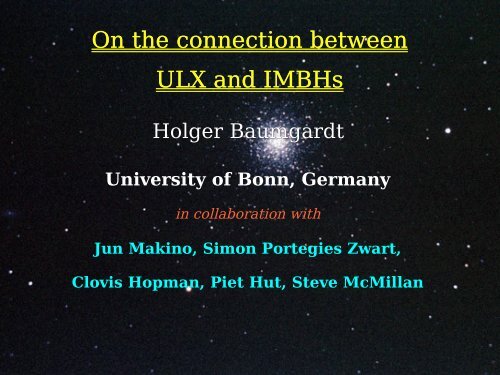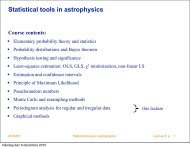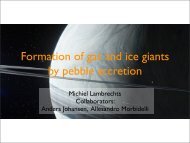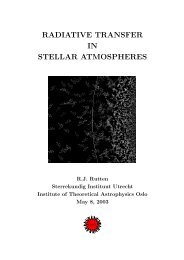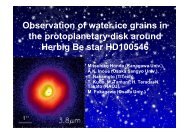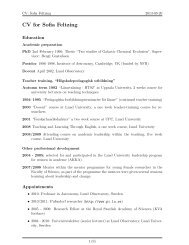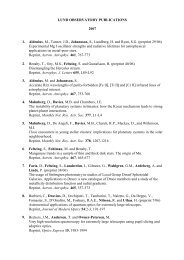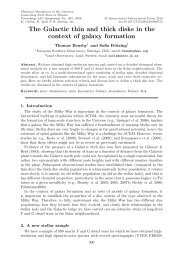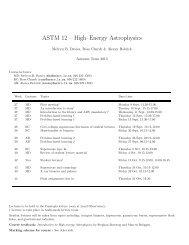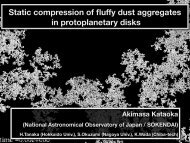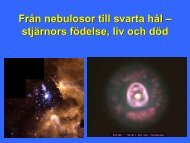On the connection between ULX and IMBHs
On the connection between ULX and IMBHs
On the connection between ULX and IMBHs
You also want an ePaper? Increase the reach of your titles
YUMPU automatically turns print PDFs into web optimized ePapers that Google loves.
Overview of <strong>ULX</strong>:➢ Ultraluminous X-ray sources (<strong>ULX</strong>) are extra-galactic,off-center X-ray sources with X-ray luminosities inexcess of 2⋅10 39erg/sec.➢ If <strong>the</strong> radiation is emitted isotropically, <strong>the</strong>y wouldexceed <strong>the</strong> Eddington luminosity of stellar-mass blackholes by many orders of magnitude.➢ They are <strong>the</strong>refore c<strong>and</strong>idates for intermediate-massblack holes (<strong>IMBHs</strong>).➢ In addition, <strong>the</strong>re is an apparent <strong>connection</strong> <strong>between</strong><strong>ULX</strong> <strong>and</strong> massive star formation regions <strong>and</strong> (possibly)young star clusters.
Formation of <strong>IMBHs</strong> in Young Clusters➢ Observations indicate that <strong>the</strong>remight be a <strong>connection</strong> <strong>between</strong> <strong>ULX</strong><strong>and</strong> star clusters.➢ Matsumoto et al. (2001) for examplefound a bright X-ray source at <strong>the</strong>center of <strong>the</strong> starburst galaxy M82with an Eddington luminositycorresponding to a black hole ofseveral hundred solar masses.➢ Optical follow-up observationsshowed that <strong>the</strong> position of thissource coincides with that of ayoung luminous star cluster.
Formation of <strong>IMBHs</strong> in Young Clusters➢ McCrady et al. (2003) used <strong>the</strong> HST<strong>and</strong> Keck telescopes to determine <strong>the</strong>density profile <strong>and</strong> total masses for anumber of young star clusters in M82.➢ MGG-11 was <strong>the</strong> most concentrated(half-light radius 1.2 pc) <strong>and</strong> secondheaviest cluster in <strong>the</strong>ir sample (M=3.5⋅10 5 M Sun).➢ In addition it appears to have a top-heavy IMF.
Formation of <strong>IMBHs</strong> in Young Clusters➢ The runaway merging leads to<strong>the</strong> formation of a single objectof more than1000 M Sunwithin afew Myrs.➢ This object could form an inter-mediate-mass black hole whichcreates <strong>the</strong> X-ray radiation.➢ Simulations of o<strong>the</strong>r clustersshow that only MGG-11 isconcentrated enough to undergorunaway merging, in agreementwith <strong>the</strong> fact that only MGG-11contains a <strong>ULX</strong>.(from Portegies Zwart et al. 2004)
<strong>On</strong>e question remaining is how to create <strong>the</strong> <strong>ULX</strong> ?
How to create a <strong>ULX</strong> out of an IMBH ?Madhusudhan et al. (2005):➢ Modeled <strong>the</strong> accretion of gas onto anIMBH from a captured donor star.➢ They found that in order to explain<strong>ULX</strong> luminosities, one needs massivestars in orbits with 6-30 R Sunaround<strong>the</strong> IMBH.
How to create a <strong>ULX</strong> out of an IMBH ?Hopman et al. (2003):➢ Performed semi-analytic calculations toinvestigate <strong>the</strong> tidal capture of stars byan IMBH.➢ Found that 10% of <strong>IMBHs</strong> in MGG-11type clusters tidally capture a star.Blecha et al. (2005):➢ Studied encounters of low-mass <strong>IMBHs</strong>with binaries in a cluster core.➢ Found a high probability for <strong>the</strong> captureof stars but only a very lowprobability that <strong>the</strong>se stars will become<strong>ULX</strong> sources.
Tidal heating:➢A star passing inside=r M BHtM S1 /3R Stidally disrupted by <strong>the</strong> black hole.of a black hole is➢Outside this radius, <strong>the</strong> star is tidally deformed by <strong>the</strong>black hole. The energy needed for <strong>the</strong> deformation istaken out of <strong>the</strong> orbital energy.➢As a result, <strong>the</strong> orbit shrinks <strong>and</strong> <strong>the</strong> star circularisesnear <strong>the</strong> black hole.➢In a star cluster, <strong>the</strong> inspiraling star has encounters witho<strong>the</strong>r stars which can scatter it away from <strong>the</strong> inspiralorbit.➢In addition, <strong>the</strong> inspiral must be slow since o<strong>the</strong>rwise <strong>the</strong>star is heated <strong>and</strong> disrupted during <strong>the</strong> inspiral.
Our runs (Baumgardt et al. 2005, astro-ph/0511752):➢ We have performed N-body simulations of <strong>the</strong> formation ofan IMBH in <strong>the</strong> center of MGG-11 <strong>and</strong> <strong>the</strong> later evolution of<strong>the</strong> cluster up to an age of 12 Myrs.➢ Our simulations included stellar evolution, tidal disruptionof stars <strong>and</strong> tidal heating of stars which pass near to anIMBH.➢ Our simulations also contained perturbations tocircularised stars from passing perturbers.Results:1) We found significant black hole growth. Depending on <strong>the</strong>mass-radius relation adopted for <strong>the</strong> runaway star, <strong>IMBHs</strong>with masses in <strong>the</strong> range 1000 to 4000 were formed.M Sun
2) A stellar cusp forms around <strong>the</strong> IMBH <strong>and</strong> due to masssegregation,massive stars are enhanced in this cusp:
3) Within <strong>the</strong> 9 Myrs of our simulations, every IMBH disruptedon average 25 stars <strong>and</strong> experienced 3 successful inspirals.4) Due to perturbations from cusp stars, successful inspiralsoriginate predominantly from low-a orbits.
5) For about 40% all inspiraled stars, <strong>the</strong> maximum energyrate pumped into <strong>the</strong>m was less than <strong>the</strong>ir Eddingtonluminosity, i.e. <strong>the</strong> stars are likely to survive <strong>the</strong> inspiral.
6) The mass transfer from <strong>the</strong> tidally circularised stars onto<strong>the</strong> IMBH is enough to power a <strong>ULX</strong> for several Myrs onaverage. Our model <strong>the</strong>refore provides an explanation for<strong>the</strong> <strong>ULX</strong> in M82 <strong>and</strong> streng<strong>the</strong>ns <strong>the</strong> <strong>connection</strong> <strong>between</strong><strong>ULX</strong> <strong>and</strong> <strong>IMBHs</strong>.


